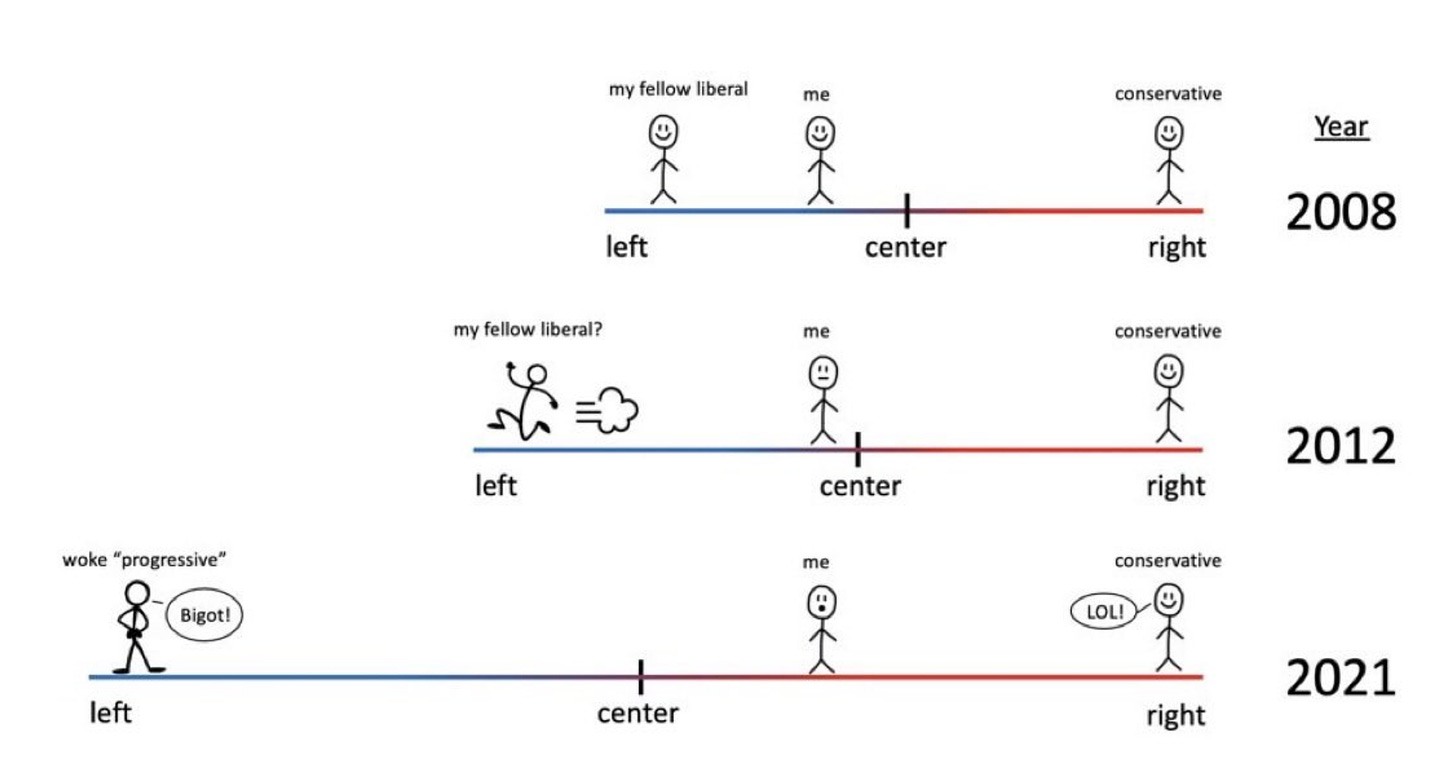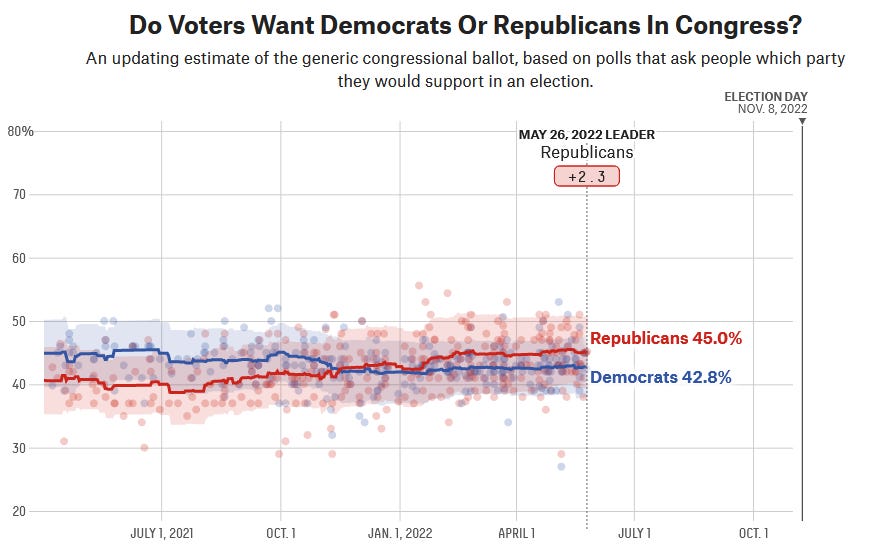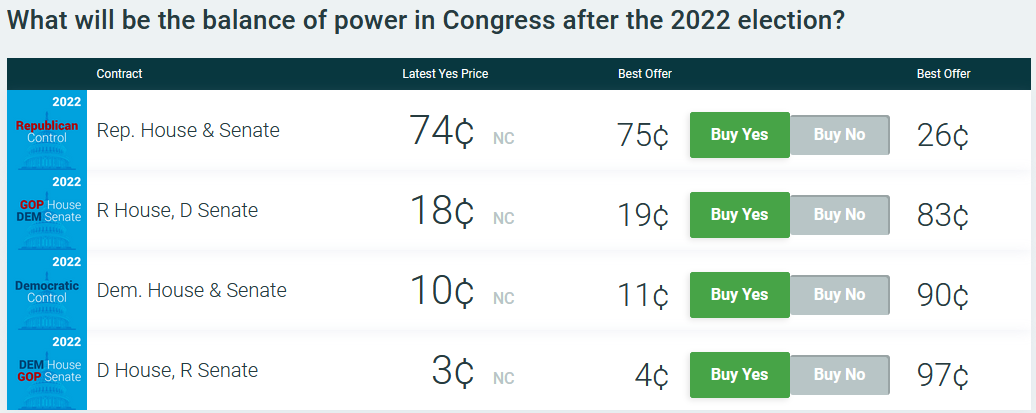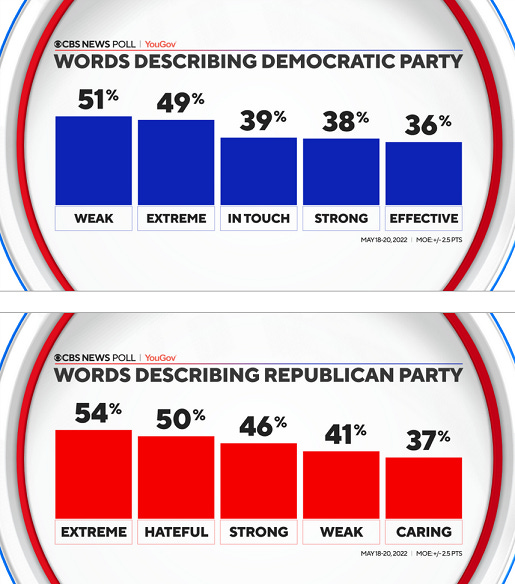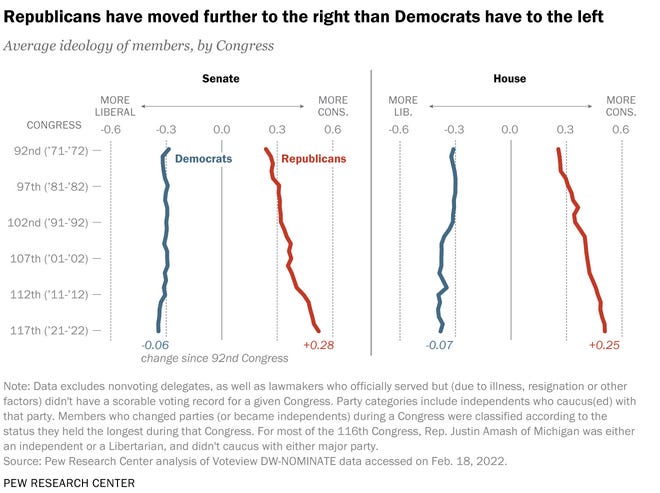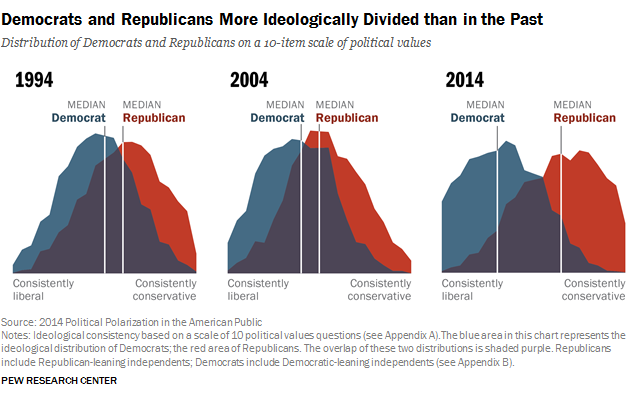Which Party Has Gotten More Extreme Faster?
Matt Yglesias has written a couple of posts (1, 2) on the subject of this meme (originally by Colin Wright, recently signal-boosted by Elon Musk):
He concludes that, contra the image where the Right stays in the same place and the Left moves, both Republicans and Democrats have “changed a lot” since 2008. He wisely avoids speculating on whether one party has moved further or faster than the other.
I’m less wise, so I’ve been trying to look into this question. My conclusion is: man, people really have strong emotions on this.
I think a lot of the disagreement happens because this is more than one question. You can operationalize it a couple different ways:
-
Which party’s policy positions have changed more in their preferred direction (ie gotten further left for the Democrats, or further right for the Republicans) since 2008 - or 1990, or 1950, or some other year when people feel like things weren’t so partisan?
-
Which party has diverged further from ordinary Americans?
-
Which party has become more ideologically pure faster than the others (ie its members all agree and don’t tolerate dissent)?
-
Which party has become crazier in terms of worldview and messaging, in a way orthogonal to specific policy proposals? That is, suppose one party wants 20% lower taxes, and plans to convene a meeting of economists to make sure this is a good idea. The other party wants 10% higher taxes, and says a conspiracy of Jews and lizardmen is holding them back, and asks its members to riot and bring down the government until they get the tax policy they want. The first party has a more extreme policy position (20% is more than 10%), but the second party seems crazier.
I think these subquestions are easier to get clear answers on and will hopefully start less of a fight, starting with…
Which Party’s Policy Positions Have Changed More In Their Preferred Direction Since Some Starting Year?
Before we get to data, we can think about this based on first principles. Which party has changed more since (let’s say) 1900 - the conservative party, or the progressive party? It’s got to be the progressive party, right? Isn’t that what “conservative” and “progressive” mean?
That is, suppose that in 1900, conservatives want to preserve the status quo, and liberals want to make “social progress” in some direction. By 1950, there’s been some social progress. Conservatives either want to go back to 1900, or perhaps maintain the 1950 status quo. Liberals want to make even more social progress. By 2000, there’s been even more social progress, and so on.
A conservative could make the following argument: “From the perspective of 1900, we’ve stayed in the same place, and the liberals have gotten more extreme. That is, we’ve consistently supported the same values as in 1900. But the liberals have gone from believing in 1900 values, to more extreme 1950s values, to even more extreme 2000s values that were totally unthinkable to anyone in 1900. For example, in 1900, maybe the conservatives wanted sodomy to be punishable with a prison sentence, and liberals wanted “only” a monetary fine. By 2000, conservatives still want a prison sentence, and liberals think gay marriage should be legal. So conservatives have stayed in exactly the same place, and liberals have gone completely off the rails.”
 The above in Wright/Musk meme format. Obviously in real life conservatives aren’t this consistent, and move left too - just at a slower rate than the liberals.
The above in Wright/Musk meme format. Obviously in real life conservatives aren’t this consistent, and move left too - just at a slower rate than the liberals.
So on a first principles argument, it seems kind of obvious that by this definition Democrats will “get more extreme” over time in a way Republicans don’t.
Might this argument fail because the literal meanings of “conservative” and “progressive” don’t correspond to their real-world use? Consider eg school vouchers, where Democrats are trying to preserve the status quo (public schools) and Republicans are proposing a bold new reform they think would work better. If there are enough cases like this, Republicans aren’t really more “conservative” than Democrats, and the argument would fail.
In order to test this, I surveyed 300 people on Tumblr (30 of whom were Republicans, although I’m not sure how much confidence you can have in the kind of Republican who goes on Tumblr). Among Republicans, 79% said they would press a magic button that replaced current policies/institutions/norms with those of 1990; among Democrats, only 33% would. The divide was equally stark for the same question asked about 1950 (31% vs. 4%). I think this amply demonstrates that the common-sense idea that Republicans are more past-looking and Democrats more future-looking is accurate.
So the first-principles case looks pretty strong. What about real data? Here’s Pew, with ten questions that I have no particular reason to believe they cherry-picked:
I don’t love some of these phrasings, but it doesn’t matter so much if the questions are loaded as long as they’re consistent across years.
When you average all of these out, Democrats have gotten 22 points more likely to support the liberal side of an issue, and Republicans have gotten 0 points more likely to support the conservative (technically 0.1, but the graphs don’t have enough significant figures to make that meaningful). This corresponds pretty exactly to the Wright/Musk meme where the conservatives stay in the same place as the liberals get more and more extreme.
A caveat: probably people are interpreting the questions differently over time. For example, “the government can’t afford to do more to help the needy” implies “more than they are currently doing ”. In 1994, the government spent about 3% of GDP on means-tested programs; in 2012 (the last year I have data for), they spent 4%. So at the beginning, the question is implicitly asking “can the government afford more than 3%?”, and at the end “can the government afford more than 4%?” But realistically ordinary people don’t know how much the government is spending and are answering based on emotional affiliations. Also, this would only strengthen the conclusion, not weaken it (saying the government should spend more than 4% is more liberal than saying it should spend more than 3%, and all the examples I can think of with these questions swing in that direction).
Commenter Alex Z mentions that in the first ten years of this period, the Democrats and Republicans were both moving left at about the same trajectory. Around 2004, the Democrats keep along the same course, but the Republicans suddenly stop, and sometimes make a tentative move rightward. From the point of a 1990s Democrat who expected both parties to keep moving left at the same rate forever, it must look like Republicans have suddenly and unilaterally defected from this happy equilibrium. Maybe this is behind some of the Democrats’ intuition that it’s the Republicans who are getting extremier faster.
Conclusion: Democrats have moved much further left on policy since 1994 than Republicans have moved right.
Which Party Has Diverged Further From Ordinary Americans?
An earlier draft of this post (visible to subscribers only) didn’t have this section. Lots of commenters objected that this was what they meant by the question “which party has gotten more extreme?” and asked me to include it.
I do so under duress: I think this is a dumb question. A corollary of the Median Voter Theorem says that both parties should be the same distance from the average voter.
This isn’t exactly true in modern America, because the Republicans have a structural advantage: small, rural states get just as many Senators as bigger states, so Republican votes are worth more, at least in the Senate. This ought to give the Republicans a little leeway to have a platform slightly to the right of equilibrium. So if we’re trying to do a first principles argument based on the median voter theorem, it would predict that the Republicans are very slightly further from ordinary Americans.
On the other hand, the Median Voter Theorem just says where you have to be in order to win. If you are dumb and bad and want to fail, you can be anywhere! You can be on the moon!
So, who’s winning? Here’s 538:
The Republicans are currently winning. That (sort of?) means most voters think the Republicans represent them better than the Democrats, which means the Republicans are probably closer to the median voter’s values. This is pretty crazy: since the Republicans are both more popular and have a structural advantage, we should expect them to win by a lot, which is indeed what people are predicting. Maybe we should have listened to David Shor about “popularism”.
Except: here’s a recent YouGov poll:
Voters are a tiny bit more likely to describe the Republicans as “extreme” than the Democrats, 54-49.
Probably it’s not worth worrying about the tiny differences between this and 538; I assume it’s within the margin of error, or pretty close. But if we insisted on doing that, we could note that the incumbent party always has a disadvantage, voters are angry at high inflation, and so they’re leaning a bit Republican to punish Biden even though the Democratic platform is slightly closer to the median voter.
Conclusion: I’m still going to call this one a tie.
Which Party Is More Ideologically Pure?
Most people who think the Republicans have extremified more than the Democrats point to DW-NOMINATE.
This is a really cool political science tool that purports to be able to measure how partisan various members of Congress (and anyone who you can correlate with members of Congress) are.
The idea is: you know those attack adds which say things like “Joe Schmoe is a dangerously extreme Democrat, he votes with Nancy Pelosi 97% of the time”? These encode an important truth: you can figure out how far right or left someone is by observing how often their vote correlates with other people’s. If we don’t want to use Nancy in particular as a lodestar, we can just correlate how often every member of Congress votes with every other member of Congress and do a dimensional analysis on the result. This finds that the pattern is usually explicable by one dimension, which correlates with our traditional left-right axis. NOMINATE starts by ranking legislators on this axis. That is, legislators form two natural clusters that tend to vote together; the more often you vote the same way as members of the left-wing cluster, the more left-wing you are.
How would you compare two different sessions of Congress? NOMINATE cleverly uses “bridge legislators” - politicians who serve multiple terms. To a first approximation, if Dianne Feinstein has been in Congress for two hundred years, and Abraham Lincoln was always to Feinstein’s right, and Alexandra Ocasio-Cortez was always to Feinstein’s left, then we know that Lincoln must be right of Ocasio-Cortez. The actual model is more complicated and allows Feinstein to change her views over the years, but this is the basic idea.
According to DW-NOMINATE, Republicans have moved further right than Democrats have left:
Lots of people take this super-seriously and consider it the answer to the question posed by the meme - see eg this article by Pew.
I am skeptical. Taking the top graph at face value, the Democratic Party in 2020 (median ideology score: - 0.37) is further right than the Democratic Party in 1880 (-0.41).
The Democratic Party of 1880 didn’t have opinions on most modern issues. But they explicitly supported racial segregation and a ban on Chinese immigrants. Implicitly, they opposed all modern welfare programs, all income taxes, any minimum wage, gay marriage, and transgender people. And DW-NOMINATE wants us to believe they were further left than modern Democrats?
Realistically the “bridge legislator” method doesn’t work over long periods; the errors add up and you get nonsense. Clearly the 1880 vs. 2020 data is nonsense. Is the 1980 vs. 2020 data that people use to argue Republicans have extremified faster also nonsense? I’m not sure.
I would prefer to avoid the over-time function, since I feel like that’s a separate question which we found a clear answer to above, and treat it as a measure of how ideologically “pure” the parties are at any given time. This is more or less its designed use case, it should be good at that, and it says the answer is that Republicans are purer than Democrats. That is, the algorithm identifying something as a right-wing issue is better at predicting Republicans will vote for it, than the algorithm identifying something as a left-wing issue is at predicting Democrats.
This is slightly fraught, because some Congressional votes are fake - for example, the Democrats might demand an extreme gun control bill that they don’t expect to pass, just so that they can say in campaign ads that such-and-such a Republican voted against gun control. Depending on how parties deploy and respond to fake votes, this could influence DW-NOMINATE a bit. I still think it’s probably accurate.
What about ordinary voters (as opposed to Congressmen?) Pew gives us this graph:
Looks pretty similar to me.
Conclusion: Republicans have shown more ideological polarization in Congress, unsure about average voters.
Which party has become crazier in terms of worldview and messaging, in a way orthogonal to specific policy proposals?
I may not be as wise as Matt Yglesias, but I am wise enough not to declare one side the winner without an ironclad dataset to back me up. I can’t think of a sufficiently good one that doesn’t feel cherry-picked.
Conclusion: Obviously your party is normal and the other one has gone completely off the rails. I’m being disgustingly “both-sides-ist” by even pretending there could be any possible equivalence. When the other party seizes power in an undemocratic coup, it will be the fault of cowards like me who refuse to call out how one party is infinitely worse than the other on this axis.
Conclusions
I think the Wright/Musk meme is clearly about the changing-policy-positions-since-some-starting-time question, and that it’s right to point to the Democrats as the main driver there.
With other interpretations, especially the ideological purity interpretation, you could point to the Republicans.
I find the changing-policy-positions one most important - all of this stuff about who votes more consistently in Congress and who endorses more conspiracy theories seems less directly important than what policies we have. If you woke up tomorrow and the Republicans were openly pushing for a literal Handmaid’s Tale theocracy, and the Democrats were just talking about the same boring small policy changes as always, it feels like it would be fair to say “Wtf, the Republicans have gotten much more extreme and I don’t like it”, even if a political scientist’s model finds that Congressional Democrats’ votes cluster slightly more tightly than Congressional Republicans’ votes or whatever. I think this is the basic point Wright and Musk are trying to make, and it’s a good one.
I’ll leave the last word to my survey respondents: On the same Tumblr survey mentioned above, I just asked people to tell me which party they thought had gotten more extreme more quickly.
Among Democrats, about 60% thought the Republicans had gotten more extreme faster, 10% thought they’d gotten more extreme faster, and 30% weren’t sure.
Among Republicans, the numbers were the exact same, only in the opposite direction.
I don’t really know what I expected here.
(Please don’t post comments with “How is this not obvious when [outgroup] has done [worst and craziest thing the outgroup has done], and [ingroup] is just doing [most moderate thing ingroup has done, framed to sound extra innocuous]!”, or I’ll delete them.)
